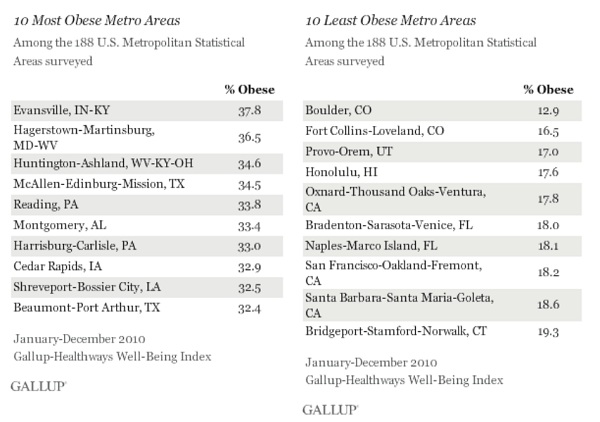
More than 20% of Americans were obese in 174 of the 188 U.S. metropolitan areas that Gallup and Healthways surveyed in 2010. In the most obese of these metro areas — Evansville, Ind.-Ky. — 37.8% of residents were obese, compared with 12.9% in the least obese place — Boulder, Colo.
Nationwide, 26.6% of American adults were obese in 2010, unchanged from 2009, but higher than 25.5% in 2008. The average obesity rate in the 10 most obese metro areas surveyed in 2010 was 34.1%, compared with 17.4% in the 10 least obese metro areas.
Gallup tracks U.S. obesity levels as part of the Gallup-Healthways Well-Being Index, using Americans’ self-reported height and weight to calculate Body Mass Index (BMI) scores. BMI scores of 30 or higher are considered obese.
The 2010 metro area findings are extracted from Gallup’s 2010 Daily tracking data set of more than 200,000 U.S. adults, aged 18 and older. Gallup categorizes U.S. metro areas according to the U.S. Office of Management and Budget’s definitions for Metropolitan Statistical Areas, and reports on all MSAs for which there are a minimum of 300 interviews available.
There is quite a bit of good information at the Gallup site, including Gallup’s U.S. City Wellbeing Tracking interactive. Check it out.
But, what is the bottom line of this information?
Good health habits have a clear connection to low disease rates and to higher wellbeing in general. Boulder, the least obese metro area of those surveyed in 2010, also has the highest overall wellbeing score in the United States. In Boulder, 65.2% of residents say they exercise for at least 30 minutes three or more days per week, more than in any other metro area. Exercise and healthy eating, in addition to helping maintain a healthy weight and prevent certain chronic diseases, have important emotional benefits.
The consequences of high obesity rates for cities come in many forms: higher healthcare costs, lower workplace productivity, and unhappier residents. For cities where more than 3 in 10 residents are obese, these problems are even more pronounced and are even more likely to continue from one generation to the next.
Government and business leaders at the city level are in a unique position to tackle the obesity problem. They are the most familiar with their community’s strengths and weaknesses and can use their knowledge to create policies and programs to target efforts to help reduce obesity in their area.
And, indeed if we all wish to lead happier, more productive and healthier lives, we must all do our part.

